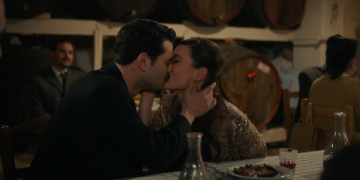Three stories of revival from a reinvented pastry to Greek bagpipes
By John Malathronas.
Instagram sensation
A cross between a croissant and a Greek pastry has seen a small cafe go viral
Yannis Kapetanakis worked in hotel administration. His brother, Kostas, was an accountant executive, while Kostas’s wife Maria worked at an engineering company. When their solid middle-management jobs vanished in the recession, the trio talked half-jokingly about opening a restaurant. In March 2013, they realised their ambition, opening Estrella cafe in Thessaloniki. With rents slashed, they could afford a prime location at Aghia Sophia Square — a popular hangout for students and teens. Then they hired food blogger Dimitris Koparanis as a chef.
Their aim was to introduce Thessaloniki to the unfamiliar delights of brunch. On 9 February 2014, Dimitris posted on Instagram a photo of what he dubbed the bougatsán — a cross between a croissant and the traditional Thessaloniki bougatsa (filo pastry filled with semolina custard). The post went viral and the rest is social media history. These days, Estrella sells 100 bougatsán a day and the Kapetanakis family has since opened a second cafe in Athens. Furthermore, Thessaloniki’s millennials have proved equally responsive to Koparanis’s other gastronomic experiments, queuing up to taste his eggs sous-vide, pizza with sesame dough and chocolate mousse made with tahini paste. As all this was achieved with zero advertising, Estrella can rightfully claim to be one of Greece’s first Instagram sensations.
Image: Alecsandra Raluca Dragoi
Back on Track
A derelict race course in a rundown suburb has been reborn as an arts hub
In late 2016, the Stavros Niarchos Foundation opened a cultural centre in the downtrodden Athens suburb of Kallithea. Built on a former horse racing track and designed by starchitect Renzo Piano, the stunning building will house both the National Library of Greece and the Greek National Opera.
While the red velour seats in the grand amphitheatre are a nod to the past, the acoustics, translation screens, soundproofed rehearsal rooms and ready-for-streaming CCTV are as technologically advanced as it gets. Situated near the cruise liners’ mooring, the Greek National Opera may also have an audience on tap.
However, for the casual tourist, the building’s biggest draw will almost certainly be its 148ft-high terrace. Shielded from the merciless Hellenic sun by a roof of photovoltaic cells, it has the sweepiest view in Athens: to the north, the Acropolis and Mount Lycabettus; on a clear day you can see all the way to Mount Parnes. To the east, Mount Hymettus hugs the coast of the ‘Attic Riviera’. To the south and west lie the Aegean and the Port of Piraeus.
When Renzo Piano arrived to start work in 2008, he asked what ‘Kallithea’ meant and was told ‘Belvedere’ — an Italian word for a structure built for its views. He looked around the garbage dump that was the old racing track and commented dryly: “I’m going to bring the Belvedere back to Kallithea.”
And so he has.
The Sound of Success
Ancient Greek instruments have found a suitably historic home
Yannis Pantazis, jazz saxophonist by profession and music historian by inclination, is the most relaxed person you’re likely to meet, seducing you with his suave bonhomie. In 2012, he and his indomitable Greek-American wife, Argy, rented La Ponta, a crumbling 13th-century Venetian tower in Santorini. Full of respect for its era-spanning architectural features, they lovingly renovated it, earning congratulations from Greece’s Ministry of Culture. The tower is now the only publicly accessible Venetian monument in Santorini and, what’s more, entrance is free.
That was only half of the dream though. Yannis and Argy turned La Ponta into an exhibition of ancient Greek instruments, with all its exhibits handcrafted by Yannis. He’s particularly keen on the tsabouna, a bagpipe common in the Aegean islands. “Although the earliest mention of bagpipes is in Aristophanes’ The Acharnians, written around 400 BC, everyone associates them with Scotland,” Yannis complains.
Each summer, he performs his own composition, Odysseus Returns, in the grounds of La Ponta. It showcases 10 ancient Greek instruments, including two kinds of Greek bagpipe, five different flutes, a cane clarinet, santoor (a Middle Eastern dulcimer) and an Apollonian lyre. International film crews flew to Santorini to film him, making him famous. His decision to follow his heart during the crisis resulted in several lean years, but, as he says: “What price your dream?”
Published in the April 2017 issue of National Geographic Traveller (UK)













































Σχόλια για αυτό το άρθρο